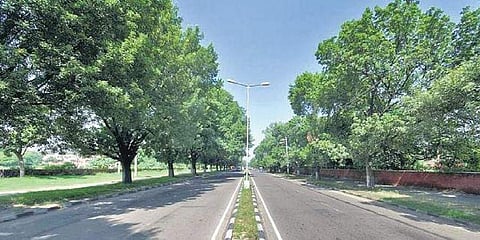

Have you ever wondered how many trees line your street? And if they are more in number than the trees that line your neighbouring street? You'll be happy to note that research fellow at the Center for Visual Information Technology (CVIT) at IIIT Hyderabad, Arpit Bahety, under the guidance of Prof CV Jawahar, and a team of researchers have come up with a possible solution. The 24-year-old along with postdocs and professors has come up with a Machine Learning algorithm that is capable of not only detecting the number of trees but also producing a colour-coded map that depicts tree coverage of a particular location, the work for which started back in the end of 2020. "This framework could help us identify which municipalities are genuinely planting more trees and the government can use this tool to reward their efforts," explains Arpit. Amazed? So were we.
Even more so when we heard from Arpit what their first step was. They placed a helmet on the rear seat of an Activa and tied a camera to it. A distance of 30 km was covered on ORR (Outer Ring Road) of Hyderabad and other areas to capture videos (read as 'collect data') of the number of trees. "Street-level view is better for counting trees than satellite view because of factors like canopies," explains the 24-year-old. Meanwhile, Yolo (You only look once) v4 model, an ML model for real-time object detection, was trained to detect trees only based on their trunks, thus omitting shrubs or smaller trees from their counting. The GPS coordinates from the route they covered were also used and developed into maps for a big picture visualisation. Using all these inputs, two maps were developed.
The category map uses an in-house scale — 20 trees per km is very low, 25-30 is low, 30-40 is moderate, 40-50 is high and greater than 50 is very high — to show which category the street falls into. The second map is about density, using the kernel density ranking algorithm (an analysis tool that calculates the density of features) to show just that, the density of trees on a route. Just like Google Maps, each area was highlighted as per the density of the tree. The team hopes that once the paper regarding this research is published, they will be able to work with the government authorities to use this data for the benefit of the green cover of the city.
From his observation, the Surat-born could tell us that while it seemed like the outskirts had fewer trees, areas like Old City had more. "This tool will come in handy to incentivise municipalities to plant more trees," he shares and adds, "This project comes under the subject of computer vision, which is about teaching Machine Learning tools to look and see. My main takeaway from this project is that I've understood how to use technologies to create some real-world impact."
For more on them check out iiit.ac.in
